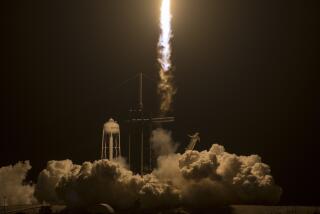Target Satellite Operating Prior to Weapon Test
- Share via
WASHINGTON — A satellite destroyed last week in a test of an Air Force anti-satellite weapon was continuing to function and send back data to Earth when it was hit, although the experiments for which it was launched had been completed, a Navy official and a space weapons expert said Thursday.
The satellite, which served as a target for the trial last Friday, was no longer in use, the Air Force said in disclosing the success of the experiment shortly after it occurred.
And the Air Force, through a Pentagon spokesman, maintained that “there is no question” that the satellite, launched to conduct Air Force experiments, was an Air Force orbiter that was no longer needed.
But the weapons expert, John Pike of the Federation of American Scientists, said that the satellite was still being used to photograph the sun’s atmosphere. Other assignments for which the satellite had been launched included studying the effect of solar wind on radio transmissions, the Air Force has said.
Pike said physicists at the Naval Research Laboratory here, anticipating data from the satellite, were surprised when they reported for work Saturday morning to find that they were no longer receiving pictures.
Photos of Sun’s Corona
He said the satellite camera, known as a coronagraph, was able to obtain pictures of the sun’s corona by blocking out the light from the sun itself on its lens--creating, in effect, an artificial eclipse. It had also been used to photograph comets.
The Navy official, spokesman Brent Baker, said that the satellite, known as P78-1, had completed its mission before it was destroyed.
“The satellite was doing several experiments, and the Navy had some experiments it was doing, but the work was completed,” he said. “As far as we were concerned, we had completed all of the experiments.”
Secretary Defends Test
Defense Secretary Caspar W. Weinberger Thursday defended the trial of the anti-satellite weapon.
“It was against . . . a burned-out satellite, and it is important that we continue doing the things necessary to acquire the capability” offered by an anti-satellite weapon, he said at a Pentagon news conference.
“The test . . . was extraordinarily successful,” Weinberger said.
The satellite was struck by a warhead launched from an F-15 fighter jet. The collision of the projectile and the satellite took place over the Western Pacific Missile Range, above Vandenberg Air Force Base, while the satellite completed one of its 100-minute orbits.
More to Read
Sign up for Essential California
The most important California stories and recommendations in your inbox every morning.
You may occasionally receive promotional content from the Los Angeles Times.













